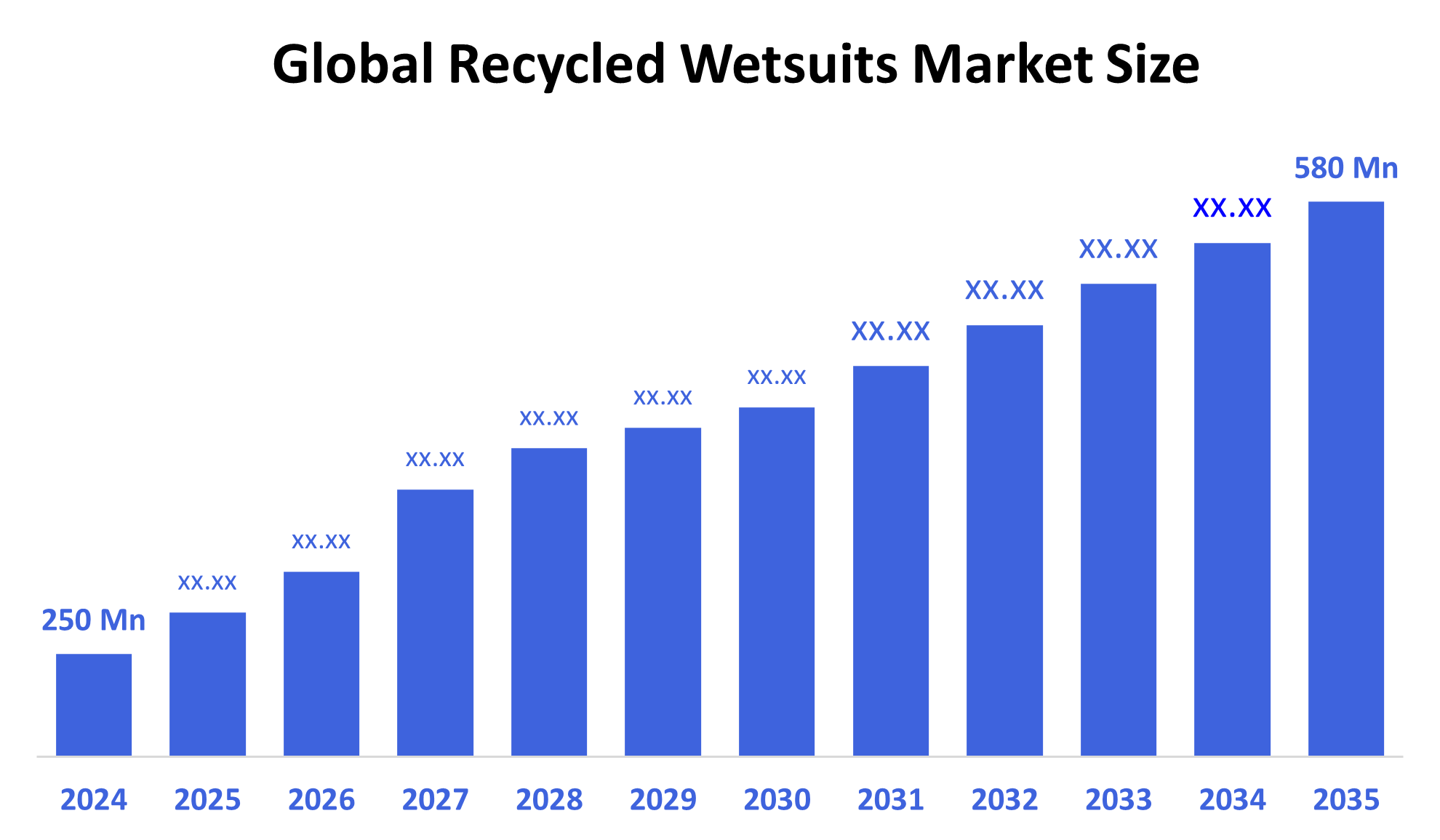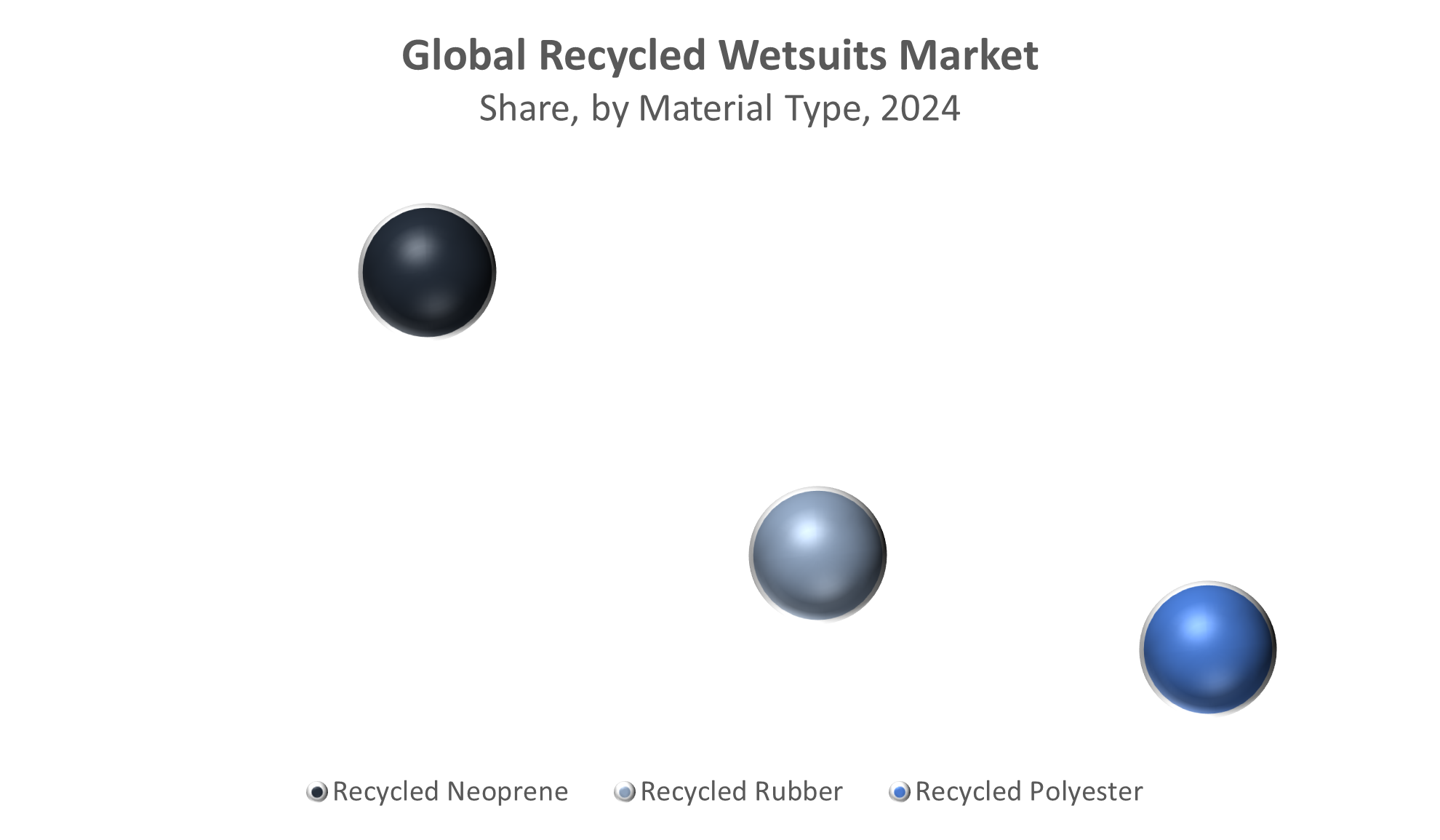Global Recycled Wetsuits Market
Global Recycled Wetsuits Market Size, Share, and COVID-19 Impact Analysis, Impact of Tariff and Trade War Analysis, By Material Type (Recycled Neoprene, Recycled Rubber, and Recycled Polyester), By Application (Surfing, Diving, and Triathlon & Open Water Swimming), and By Region (North America, Europe, Asia-Pacific, Latin America, Middle East, and Africa), Analysis and Forecast 2025-2035.
Report Overview
Table of Contents
Recycled Wetsuits Market Summary, Size & Emerging Trends
According to Spherical Insights, The Global Recycled Wetsuits Market Size is Expected To Grow From USD 250 Million in 2024 to USD 580 Million by 2035, at a CAGR of 7.8% during the Forecast Period 2025-2035. Growing environmental awareness and the push for sustainability in water sports gear are key drivers fueling this growth.

Key Market Insights
- Asia Pacific dominates the market with the largest revenue share, driven by major surfing and diving hubs.
- Recycled neoprene leads the material segment due to its superior flexibility and insulation.
- Surfing application holds the largest share, fueled by a global increase in recreational surfers adopting eco-conscious gear.
Global Market Forecast and Revenue Outlook
- 2024 Market Size: USD 250 Million
- 2035 Projected Market Size: USD 580 Million
- CAGR (2025-2035): 7.8%
- Asia Pacific: Largest market in 2024
- Europe: Fastest growing market
Recycled Wetsuits Market
The recycled wetsuits market centers on producing wetsuits from sustainable recycled materials like neoprene, rubber, and polyester. These wetsuits meet growing consumer demand for environmentally responsible products without compromising on durability and performance. Innovations in material recycling technologies and circular manufacturing processes improve quality and reduce waste. The market is supported by eco-conscious surfers, divers, and triathletes, as well as manufacturers and retailers committed to green initiatives. Government regulations encouraging sustainable product use and corporate responsibility initiatives are expected to boost market expansion globally.
Recycled Wetsuits Market Trends
- Increasing consumer preference for sustainable and ethical water sports gear.
- Advancements in recycled neoprene production enhancing wetsuit flexibility and thermal protection.
- Rising collaborations between sports brands and environmental organizations promoting recycled wetsuits.
- Growth of online eco-friendly product platforms enabling wider reach to conscious buyers.
Recycled Wetsuits Market Dynamics
Driving Factors: The recycled wetsuits market is propelled by increasing environmental awareness
The recycled wetsuits market is propelled by increasing environmental awareness among consumers who seek sustainable alternatives in water sports gear. As surfing, diving, and triathlon participation rises globally, so does the demand for eco-friendly wetsuits that reduce plastic and neoprene waste. Innovations in recycled material technologies, such as advanced recycled neoprene and polyester, have significantly improved the quality and performance of sustainable wetsuits. This encourages environmentally conscious consumers to prefer recycled options over traditional wetsuits, supporting both ecological benefits and market growth.
Restraining Factors: Higher production costs for recycled materials make these wetsuits more expensive than conventional ones
Despite rising interest, higher production costs for recycled materials make these wetsuits more expensive than conventional ones, limiting accessibility for price-sensitive buyers. Technical challenges also exist in maintaining durability and thermal protection during recycling, which can impact product longevity and consumer confidence. Additionally, in many regions, awareness about recycled wetsuits and their benefits remains low, restricting market expansion. Manufacturers face difficulties educating consumers and building trust, which slows adoption. These factors collectively restrain the rapid growth of recycled wetsuits, especially in developing markets or among casual water sports participants.
Opportunities: The market benefits from expanding direct-to-consumer sales through brand websites
The market benefits from expanding direct-to-consumer sales through brand websites and growing specialty eco-friendly stores, which help educate buyers and increase accessibility. Government incentives and NGO campaigns promoting sustainable products provide vital support and raise consumer interest in recycled wetsuits. Furthermore, ongoing material innovations, especially in recycled polyester and rubber, open doors for diversifying product lines, improving comfort, flexibility, and eco-performance. Emerging economies with rising water sports participation present new growth frontiers. Brands can capitalize on these opportunities by investing in marketing, R&D, and strategic partnerships focused on sustainability.
Challenges: Sourcing consistent, high-quality recycled materials remains a critical challenge
Sourcing consistent, high-quality recycled materials remains a critical challenge, leading to supply chain disruptions that affect manufacturing reliability and costs. Additionally, competition from traditional synthetic and non-recycled wetsuit manufacturers is intense, especially where cost considerations dominate consumer decisions. The absence of standardized certifications and transparent sustainability claims for recycled wetsuits complicates consumer trust, as buyers are wary of greenwashing. The evolving regulatory landscape also creates uncertainty. Companies must address these challenges by improving supply chains, enhancing transparency, and advocating for industry-wide sustainability standards to sustain growth and consumer confidence.
Global Recycled Wetsuits Market Ecosystem Analysis
The ecosystem comprises recycled material suppliers, wetsuit manufacturers, brand owners, retail distributors, online marketplaces, and end-users including recreational surfers, professional divers, and triathletes. Collaboration between material recyclers and wetsuit designers is critical to improve product innovation. Retailers and e-commerce platforms play a vital role in educating consumers and expanding market reach. Regulatory bodies and environmental organizations influence market dynamics by promoting sustainability standards and certifications.
Global Recycled Wetsuits Market, By Material Type
Recycled neoprene dominates the global recycled wetsuits market with about 55% market share. This is because it provides excellent thermal insulation, keeping users warm in cold water, which is essential for surfing and diving. It also offers great flexibility, allowing freedom of movement, and strong durability to withstand rough conditions. These qualities make recycled neoprene the preferred material for high-performance wetsuits. Its eco-friendly nature further appeals to environmentally conscious consumers looking for sustainable alternatives without compromising on wetsuit functionality.

Recycled rubber holds around 25% of the market and is primarily used in wetsuit soles and protective parts. It adds toughness and wear resistance to areas exposed to more friction and impact. Using recycled rubber not only enhances durability but also supports environmental sustainability by reducing rubber waste. Though it’s less versatile than recycled neoprene, it plays a crucial role in reinforcing wetsuit components, making it an important material in the recycled wetsuits market.
Global Recycled Wetsuits Market, By Application
Surfing is the largest segment in the global recycled wetsuits market, capturing about 45% of the share. This growth is fueled by the expanding global surfing community, especially among environmentally conscious surfers who prefer sustainable gear to help protect the oceans they love. Recycled wetsuits offer performance and eco-friendliness, making them popular choices for surfers who want to reduce plastic and neoprene waste while enjoying their sport.
Diving accounts for roughly 30% of the recycled wetsuits market. Both professional and recreational divers are increasingly choosing recycled wetsuits as part of their commitment to eco-conscious underwater exploration. These wetsuits provide necessary thermal protection and durability while supporting sustainability, which aligns with divers’ appreciation for marine environments and the need to minimize environmental impact.
Asia Pacific dominates the global recycled wetsuits market, contributing nearly 40% of total revenue. This leadership is driven by countries such as Australia, Japan, and Indonesia, where surfing and diving are extremely popular. The region benefits from rapid industrialization, increasing disposable incomes, and a growing middle class. Additionally, strong environmental awareness and active sustainability movements encourage the adoption of eco-friendly products like recycled wetsuits. These factors collectively create a favorable environment for market growth.
Europe is the fastest-growing region in the recycled wetsuits market, with a CAGR of about 9%. This growth is propelled by stringent sustainability regulations and policies aimed at reducing environmental impact. Eco-conscious consumers in countries like the UK, France, and Germany are increasingly demanding sustainable sportswear options. Additionally, expanding participation in water sports activities further drives the market, supported by strong government and NGO initiatives promoting green products.
North America holds a significant market share, supported by widespread participation in outdoor recreational activities, including surfing and diving. The U.S. and Canada serve as innovation hubs, with companies developing advanced recycled wetsuit technologies. High consumer awareness around sustainability and environmentally friendly products also boosts market growth in this region.
WORLDWIDE TOP KEY PLAYERS IN THE RECYCLED WETSUITS MARKET INCLUDE
- Patagonia
- Rip Curl
- Xcel Wetsuits
- Eco Wetsuits
- Outerknown
- Billabong
- Vissla
- O’Neill
- Matuse
- Yulex Corporation
- Others
Product Launches in the Recycled Wetsuits Market
- In June 2024, Liberated Brands, operating under Billabong, introduced the “Upcycler” wetsuit, the first of its kind made from post-consumer recycled wetsuits and textiles. This groundbreaking product utilizes discarded wetsuit liners and textiles, repurposing them into raw materials for the internal rubber. Additionally, the wetsuit features an all-natural, FSC-certified rubber formulation sourced from the Hevea brasiliensis tree, eliminating the need for petroleum-based materials
Market Segment
This study forecasts revenue at global, regional, and country levels from 2020 to 2035. Spherical Insights has segmented the recycled wetsuits market based on the below-mentioned segments:
Global Recycled Wetsuits Market, By Material Type
- Recycled Neoprene
- Recycled Rubber
- Recycled Polyester
Global Recycled Wetsuits Market, By Application
- Surfing
- Diving
- Triathlon & Open Water Swimming
Global Recycled Wetsuits Market, By Regional Analysis
- North America
- US
- Canada
- Mexico
- Europe
- Germany
- UK
- France
- Italy
- Spain
- Russia
- Rest of Europe
- Asia Pacific
- China
- Japan
- India
- South Korea
- Australia
- Rest of Asia Pacific
- South America
- Brazil
- Argentina
- Rest of South America
- Middle East & Africa
- UAE
- Saudi Arabia
- Qatar
- South Africa
- Rest of the Middle East & Africa
FAQs
Q: What material type leads the Global Recycled Wetsuits Market?
A: Recycled neoprene leads the material segment with about 55% market share.
Q: Which application segment holds the largest share in the Global Recycled Wetsuits Market?
A: Surfing holds the largest share, capturing about 45% of the market.
Q: What are the main drivers of growth in the recycled wetsuits market?
A: Growing environmental awareness, increasing participation in water sports, and innovations in recycled material technologies.
Q: What restrains the growth of the recycled wetsuits market?
A: Higher production costs for recycled materials, technical challenges in maintaining durability, and low consumer awareness in some regions.
Q: What opportunities exist in the recycled wetsuits market?
A: Expansion of direct-to-consumer sales through brand websites, government incentives, and ongoing material innovations.
Q: What challenges does the recycled wetsuits market face?
A: Sourcing consistent, high-quality recycled materials, competition from traditional wetsuits, and lack of standardized certifications.
Q: Who are the key players in the Global Recycled Wetsuits Market?
A: Key players include Patagonia, Rip Curl, Xcel Wetsuits, Eco Wetsuits, Outerknown, Billabong, Vissla, O’Neill, Matuse, and Yulex Corporation.
Q: Can you provide an example of a recent product launch in the recycled wetsuits market?
A: In June 2024, Liberated Brands (Billabong) launched the “Upcycler” wetsuit made from post-consumer recycled wetsuits and textiles with FSC-certified natural rubber.
Check Licence
Choose the plan that fits you best: Single User, Multi-User, or Enterprise solutions tailored for your needs.
We Have You Covered
- 24/7 Analyst Support
- Clients Across the Globe
- Tailored Insights
- Technology Tracking
- Competitive Intelligence
- Custom Research
- Syndicated Market Studies
- Market Overview
- Market Segmentation
- Growth Drivers
- Market Opportunities
- Regulatory Insights
- Innovation & Sustainability
Report Details
| Pages | 235 |
| Delivery | PDF & Excel via Email |
| Language | English |
| Release | Sep 2025 |
| Access | Download from this page |
